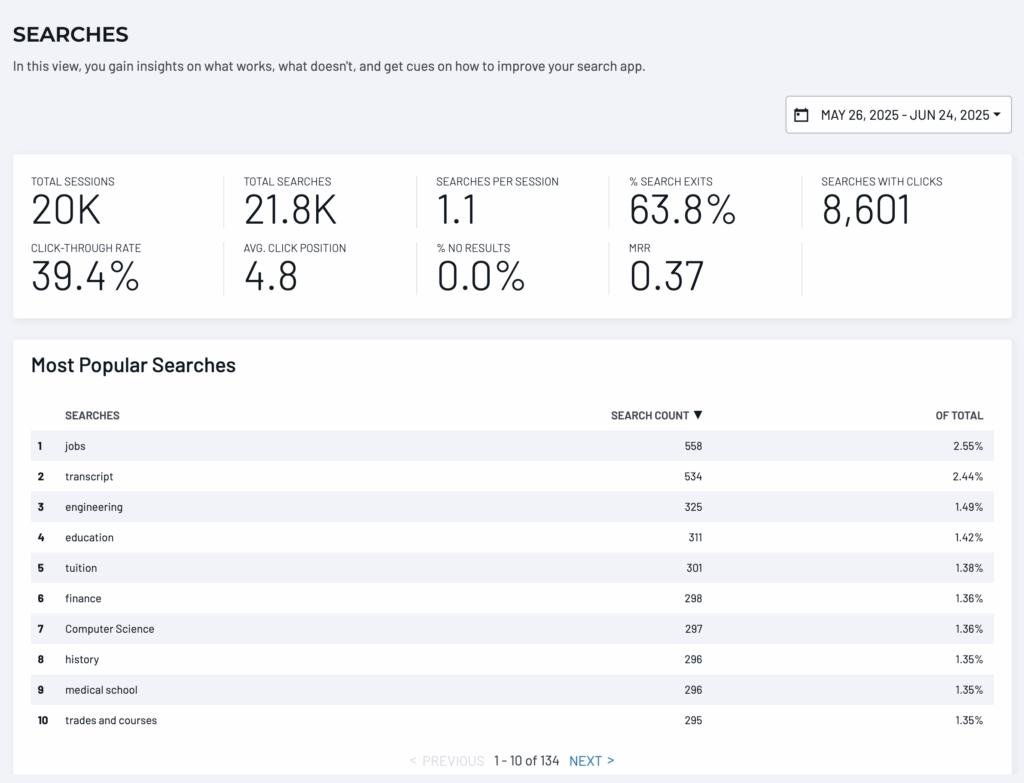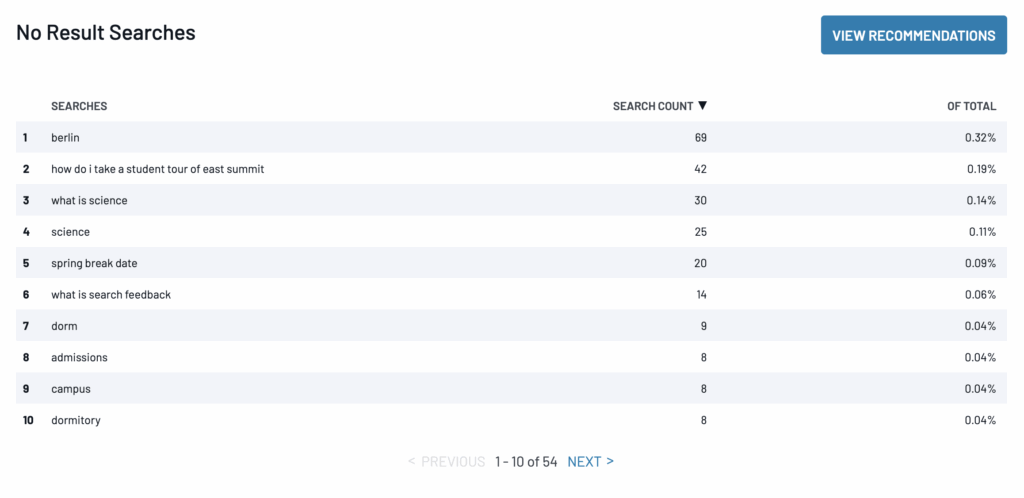October 07, 2024
John Abbasi
|
*Updated January 2025*
Content gaps can create dead ends and break the visitor experience on your site. Here are some essential considerations for how to avoid these issues with content gap analysis.
A New Take on Content Gap Analysis
No matter how effective your content strategy is, content gaps are bound to exist on your website. But this doesn’t mean your organization is helpless against the issue.
Content gap analysis gives you a way to identify and address any missing pieces of content on your website, and provides a logical framework to fill in these gaps. Right now, there’s an evolution in gap analysis taking place that gives marketing teams a leg up on informing their content strategy.
Contrary to common practice, relying on competitor research to fuel your content gap analysis isn’t the only way forward; you can uncover so much more about what your website visitors specifically want to discover by using your site search data.
Site search gives you first-party data, charged with the highest visitor intent possible. So when that data reveals a gap, it’s time to listen and react.
In this guide, we’ll go over the basic concepts of content gaps, introduce how to effectively establish content gap analysis and show how to use site search to fill content gaps and maximize your content strategy.
What is a Content Gap?
A content gap is the difference between the content your visitors want and what you actually provide on your website; it represents topics that haven’t been covered in an organization’s content, or topics that do exist within your site but are outdated.
For example, let’s say a healthcare website creates helpful guides for common cold, flu and other ailments. Their blog covers the latest information for those commonly searched illnesses. However, a new strain of virus is running rampant and people need to know what precautions to take to avoid that new disease and how to treat it when contracted.
If that healthcare organization doesn’t move quickly to update their site to deliver content on that new relevant topic, they may find themselves with a significant content gap as their users search their site for information and answers. Visitors’ only option would be to bounce back to Google to find a website that includes the information they need.
The above example shows the importance of analyzing and addressing content gaps. When a website visitor encounters a content gap, they’re less likely to stick around, meaning you’ll miss out on a chance for them to fill out a form or click through to a related article to find what they’re looking for.
Content gaps also negatively impact search engine optimization (SEO), as continued failure to serve users the content they want will signal to search engines that your site lacks authority on key subjects within your industry.
To prevent these potentially negative outcomes, you need content gap analysis.
What is Content Gap Analysis?
Content gap analysis helps organizations find important pieces of content within their field of expertise that aren’t included in their current content layout. It’s a tool that marketers should have in their arsenal to inform their content strategy.
A good content gap analysis process evaluates a website’s current content and then helps teams understand what type of content strategy could be implemented to fill those gaps.
Content gap analysis benefits include:
- Better overall user experience. A website visitor expects a streamlined navigation each time they land on a webpage. Running into content gaps is a hiccup that will disrupt that journey. Your analysis will provide insight into where this disruption is happening or is likely to happen.
- Improved SEO. Content gaps prevent optimal search rankings, as your competitors might rank for keywords and topics that you haven’t yet created or haven’t updated. A good content gap analysis helps you locate areas for improvement.
- Opportunity to distance yourself from competition. Content gap analysis can shine a light on your website’s own content opportunities, as well as gaps in the market. The analysis might find a key topic that your competitors haven’t written about, leaving an opportunity to give your site a competitive edge.
Site Search: The Key to Identifying and Targeting Content Gaps
When looking for ways to overcome content gaps, you want all the tools available at your disposal. One powerful method is gaining a deeper understanding of your onsite search and what popular searches are leaving your visitors with no results. It’s a unique way to break through the basics of traditional content gap research and target exactly what your visitors are telling you they want.
So how can you go about including site search into your content gap analysis and content strategy? Implementing a modern, effective site search solution is the first step, providing you with a comprehensive way to review and understand your onsite search.
A site search solution should provide you with a complete overview of how users interact with your website’s search function. Analysis features allow teams to understand visitor intent and pinpoint content gaps.

SearchStax Site Search solution, pictured above, provides critically important onsite search data, including the percentage of searches that returned no results, which highlights potential content gaps for you to dig into.
The No Result Searches feature lists exactly which search queries your audience is issuing and will help you discover where you content strategy could better serve their needs.

An important note to consider is that some content gaps are okay to have on your site. Some of your visitors, especially those in the very top of your funnel, may have expectations in their discovery phase that don’t match what your organization offers.
If they’re searching for products/services that you don’t offer, you shouldn’t develop content for those subjects. Instead, optimize your site search user experience (UX) to make sure that no results pages have resources that urge them to discover other content that you do deliver.
5 Easy Steps to Conduct an Effective Content Gap Analysis
To help you get started with eliminating content gaps, we’ve put together a list of the 5 steps needed to build a powerful content gap analysis process:
- Identify Your Target Market
- Research Keywords Using the Right Tools
- Analyze Competitor Content
- Review Existing Content Periodically
- Revise Your Content Plan
1. Identify Your Target Market
The first thing you’ll want to understand is the core audience you’re trying to reach. After that, it will help to know their specific needs.
Before we can truly know what our customers want from their content searches, we should have a firm grasp of who they are. Here are some effective ways to identify your target audience:
- Identify the most relevant customer profiles within your industry
- Focus on your current customers and categorize them
Once you know your customers, it’s important to drill down to their needs. Here are some helpful hints:
- Understand common pain points for users searching for products or services like yours
- Analyze available data regarding customer behavior, including onsite search behavior
- Offer current customers a way to give feedback
2. Research Keywords Using the Right Tools
Keyword research is a common method for guiding content gap analysis. This reveals new potential topics for your content strategy.
There are plenty of tools to help you discover relevant keywords for wider top of funnel exposure as well as more niche, long-tail terms that match closer to your visitors’ intent. Tools like Moz, Semrush, Ahrefs and Google Search Console all have powerful features for keyword research.
That’s the proactive side of keyword research; on the other side of the coin, site search equips you for the reactive side, where you can look at your onsite search trends and develop content based on the terms your visitors are typing into your search bar (as detailed earlier).
3. Analyze Competitor Content
One of the easiest ways to research and analyze your content gaps is to look at competitor content.
This should be a two-pronged approach. On one front, you have your direct competitors who are other businesses or organizations that are targeting the same audience and offer a similar product or service.
It’s essential to know your direct competitors and the types of content and keywords they’re going after. If they’re delivering value to the same audience you’re targeting and you don’t have content on that same subject, it’s time to fill that gap.
The other consideration here is your search engine results page (SERP) competitors. SERPs, especially in Google, are a whole different battleground. Once you’ve identified target keywords through your research, you then need to search those keywords and see who’s winning the SEO game.
Those top ranking SERP competitors may or may not be your direct competitors for products and services, but they are taking market share of organic search traffic. That means you have to develop content to outrank them to earn some of that relevant traffic.
For example, if a university in California wanted to rank their content for their teaching credential program, it would be important to search relevant keyword phrases and see who the competitors are.

As seen here, National University and Cal State Long Beach are both direct competitors and SERP competitors, while other resources that are not universities on the page are simply search competitors.
When doing competitor research for content gaps, it’s essential to audit their content closely, find where you can improve your content offerings to add more value than they do and even pinpoint outdated content where you can find easier wins.
Tools like Semrush can help you with side-by-side evaluations of your keyword profile compared to competitors for direct gap analysis.
4. Review Existing Content and Schedule Periodic Evaluations
Reviewing your content regularly for opportunities to refresh and update it is an important practice. You don’t want your website to be the one with gaps for competitors to take advantage of. With that in mind, you should make a concerted effort to review your content on a regular schedule to make sure it isn’t collecting digital dust.
One helpful way to dig deep into your existing content is with tools like Google Analytics or Semrush, which can provide insight into how well a website’s content is performing. It’s also important to create a systemized spreadsheet to keep track of keywords, hyperlinking structures and publication dates.
Heat mapping tools can also be a big help here. These tools allow you to watch session recordings to understand how people are interacting with your content, see your most clicked buttons and CTAs and get an understanding of scroll depth on your pages (to see where visitors are falling off).
5. Create a New Content Plan
Now that you’ve identified potential content gaps, it’s time to construct a strategy to create content. Organization is key for this, so consider keeping track of existing and pending content, content publication dates and other important metrics in a spreadsheet that is shared to relevant team members.
A detailed calendar view also goes a long way for keeping cross-functional teams on the same page for when drafts, designs and other assets are due.
Don’t forget to include when those pieces are due for a refresh to help boost rankings and ensure that your content doesn’t stagnate.
Content Format for Filling Gaps
With a plan in place to fill content gaps, let’s briefly touch on some different content types that could best fulfill the search intent of users.
- FAQs. Frequently Asked Question pages help create a better customer experience on your site, save users time and contribute to SEO best practices. In creating your FAQ page, you’ll have a better overall picture of what types of questions need to be included, both now and in the future, to meet the content needs of website visitors.
- Comparison pages. A comparison page can be a guiding force behind a potential customer’s decision to sign up for your product or service, or leave for a competitor. This is a direct chance to draw a line between the value of your product or service and the competitor’s.
- How-to guides. Website visitors, especially new ones, often use the onsite search feature to ask a question related to their needs (basic product or service information, how to use a product, etc.). A how-to guide can be a helpful way to fulfill that need quickly and educate your target audience effectively. These guides can also be used internally to help employees find information they need to know.
- Product deep dive pages. Detailed product pages drive search results and maximize customer experience. They’re your most direct way of communicating value and speaking to the features of your offerings. Product pages can also fill in content gaps that might arise from your site search data. You can make sure that these pages show up when certain popular (and relevant) searches are issued.
- Resource pages. For other organizations in industries like higher education, healthcare and government, their most important pages aren’t product pages. Their websites generally need to prioritize content-rich resource pages for key information about programs and services.
- Multimedia offerings. Search results are filled with all types of content solutions to meet user search intent. For example, a video explaining a topic might be a more impactful and helpful type of content. Be sure to implement a wide array of media into your content plan.
Monitoring Content Quality
Once you’ve filled the content gaps you uncovered, the last thing to do is maintain the quality of this content.
Monitoring your content’s quality ensures that the information you have available on your website meets the needs of visitors and stays current and relevant. You can find helpful tech tools, such as Screaming Frog or Ahrefs, to make ongoing analysis easier.
Be sure to conduct regularly scheduled content audits to avoid content gaps. Depending on your industry and how many times you overhaul your content strategies and website, you can aim for at least one content audit every 6-12 months, adjusting as needed. For specific core content pieces, you may want to refresh on a more frequent schedule to ensure it’s relevant and up to date.
Lastly, monitor important industry trends and user behavior on your website to stay ahead of the curve in your content strategies. If you want to level up your site search to have an inside track to content gaps, popular searches and more, check out our Site Search Solution.




